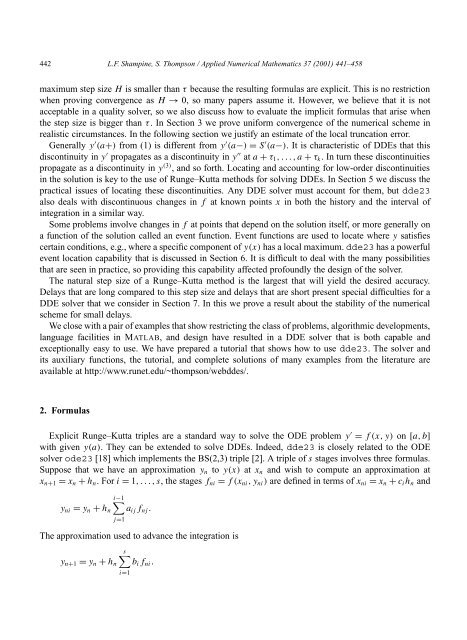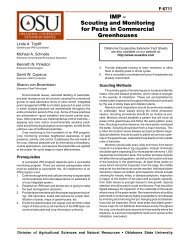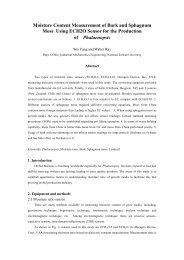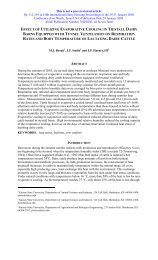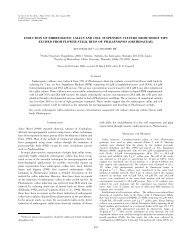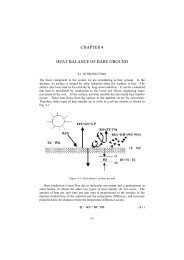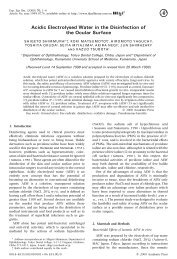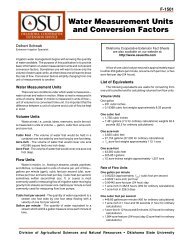Solving DDEs in MATLAB
Solving DDEs in MATLAB
Solving DDEs in MATLAB
You also want an ePaper? Increase the reach of your titles
YUMPU automatically turns print PDFs into web optimized ePapers that Google loves.
442 L.F. Shamp<strong>in</strong>e, S. Thompson / Applied Numerical Mathematics 37 (2001) 441–458<br />
maximum step size H is smaller than τ because the result<strong>in</strong>g formulas are explicit. This is no restriction<br />
when prov<strong>in</strong>g convergence as H → 0, so many papers assume it. However, we believe that it is not<br />
acceptable <strong>in</strong> a quality solver, so we also discuss how to evaluate the implicit formulas that arise when<br />
the step size is bigger than τ . In Section 3 we prove uniform convergence of the numerical scheme <strong>in</strong><br />
realistic circumstances. In the follow<strong>in</strong>g section we justify an estimate of the local truncation error.<br />
Generally y ′ (a+) from (1) is different from y ′ (a−) = S ′ (a−). It is characteristic of <strong>DDEs</strong> that this<br />
discont<strong>in</strong>uity <strong>in</strong> y ′ propagates as a discont<strong>in</strong>uity <strong>in</strong> y ′′ at a + τ1,...,a+ τk. In turn these discont<strong>in</strong>uities<br />
propagate as a discont<strong>in</strong>uity <strong>in</strong> y (3) , and so forth. Locat<strong>in</strong>g and account<strong>in</strong>g for low-order discont<strong>in</strong>uities<br />
<strong>in</strong> the solution is key to the use of Runge–Kutta methods for solv<strong>in</strong>g <strong>DDEs</strong>. In Section 5 we discuss the<br />
practical issues of locat<strong>in</strong>g these discont<strong>in</strong>uities. Any DDE solver must account for them, but dde23<br />
also deals with discont<strong>in</strong>uous changes <strong>in</strong> f at known po<strong>in</strong>ts x <strong>in</strong> both the history and the <strong>in</strong>terval of<br />
<strong>in</strong>tegration <strong>in</strong> a similar way.<br />
Some problems <strong>in</strong>volve changes <strong>in</strong> f at po<strong>in</strong>ts that depend on the solution itself, or more generally on<br />
a function of the solution called an event function. Event functions are used to locate where y satisfies<br />
certa<strong>in</strong> conditions, e.g., where a specific component of y(x) has a local maximum. dde23 has a powerful<br />
event location capability that is discussed <strong>in</strong> Section 6. It is difficult to deal with the many possibilities<br />
that are seen <strong>in</strong> practice, so provid<strong>in</strong>g this capability affected profoundly the design of the solver.<br />
The natural step size of a Runge–Kutta method is the largest that will yield the desired accuracy.<br />
Delays that are long compared to this step size and delays that are short present special difficulties for a<br />
DDE solver that we consider <strong>in</strong> Section 7. In this we prove a result about the stability of the numerical<br />
scheme for small delays.<br />
We close with a pair of examples that show restrict<strong>in</strong>g the class of problems, algorithmic developments,<br />
language facilities <strong>in</strong> <strong>MATLAB</strong>, and design have resulted <strong>in</strong> a DDE solver that is both capable and<br />
exceptionally easy to use. We have prepared a tutorial that shows how to use dde23. The solver and<br />
its auxiliary functions, the tutorial, and complete solutions of many examples from the literature are<br />
available at http://www.runet.edu/~thompson/webddes/.<br />
2. Formulas<br />
Explicit Runge–Kutta triples are a standard way to solve the ODE problem y ′ = f(x,y) on [a,b]<br />
with given y(a). They can be extended to solve <strong>DDEs</strong>. Indeed, dde23 is closely related to the ODE<br />
solver ode23 [18] which implements the BS(2,3) triple [2]. A triple of s stages <strong>in</strong>volves three formulas.<br />
Suppose that we have an approximation yn to y(x) at xn and wish to compute an approximation at<br />
xn+1 = xn + hn.Fori = 1,...,s, the stages fni = f(xni,yni) are def<strong>in</strong>ed <strong>in</strong> terms of xni = xn + cihn and<br />
i−1<br />
<br />
yni = yn + hn<br />
j=1<br />
aij fnj .<br />
The approximation used to advance the <strong>in</strong>tegration is<br />
yn+1 = yn + hn<br />
s<br />
i=1<br />
bifni.


